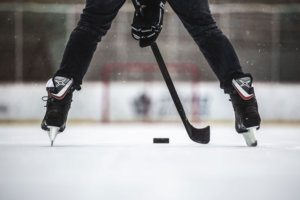The hockey season is long and arduous, and with the Stanley Cup Finals wrapping up, many of us hockey fans will be without excitement for the next few months. I know, we might all be somewhat selfish in wanting that face paced ice skating, fanciful puck handling, and voracious fighting all year round but I bet the players are thankful for some time to finally kick off their skates and relax.
This gets me thinking a bit about what hockey players really do during their recovery months and how they start to prepare for the upcoming seasons. A few years ago I was fortunate to take the NSCA’s summer hockey clinic (online of course – although I would have loved to go to Denver to watch everything in person) and learned a thing or two about the types of muscle groups that hockey players really need to concentrate on to prepare for the upcoming season and what their physical testing consists of.
Physical Testing, hockey style!
According to the NHL, some of the tests that prospective hockey players must endure to make a team include the Wingate aerobic test, Pull ups, Pro agility test, Bench Press, Standing long jump, Y- balance, and FMS. Some of these tests seem standard when you think about what kinds of things a hockey player might need when on the ice, for example the Wingate measures aerobic capacity and the standing long jump is a measure of power. Other tests like pull ups and bench press made me think a bit more about why those tests were chosen and how each of those muscle groups are being activated when playing hockey.
It all seems like a Dream
 About 10 years ago I had the opportunity to take part in something incredible and spend a good portion of my year upstate in Lake Placid at the Olympic Training Center. It was here that I was able to train side by side with some of the best hockey players America has to offer, Team USA themselves! When I saw some of them in person perform pull ups with 35-40 extra pounds, sprint just as fast as bobsled athletes, and bench press my entire body weight like nothing my eyes would light up. I realized I wanted to be just as strong and powerful as them. To this day when I get under the bar and perform these movements, I remember watching those women train and use that as motivation to push harder and get stronger.
About 10 years ago I had the opportunity to take part in something incredible and spend a good portion of my year upstate in Lake Placid at the Olympic Training Center. It was here that I was able to train side by side with some of the best hockey players America has to offer, Team USA themselves! When I saw some of them in person perform pull ups with 35-40 extra pounds, sprint just as fast as bobsled athletes, and bench press my entire body weight like nothing my eyes would light up. I realized I wanted to be just as strong and powerful as them. To this day when I get under the bar and perform these movements, I remember watching those women train and use that as motivation to push harder and get stronger.
Stronger Lats = More core stability!
Fast forward to today, I am a physical therapist in NYC and strength and conditioning specialist and have more knowledge on why these muscle groups are important. Days like today make me wish I could go back in time and tell the younger version of myself why training in a certain way is so important. For example, pull ups train the latissimus dorsi, a massive back muscle that connects your arm to your pelvis. This is the entire back of your core! This muscle is very frequently looked over in it’s importance for core stability but this and the transverse abdominus (low core) together really create the base for your extremities to move on. So what does this mean? Stronger skating, harder hits, and better shots! Pull ups finally make sense now!
Schedule an Appointment for Physical Therapy in NYC
If you are looking to increase core control or just want to talk more about strength training – pop in or shoot me an e-mail! I would love to hear more about what your thoughts are on this topic!
